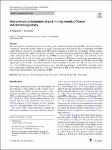Item Infomation
Full metadata record
| DC Field | Value | Language |
|---|---|---|
| dc.contributor.author | Podgórska, M. | - |
| dc.contributor.author | Jóźwiak, M. | - |
| dc.date.accessioned | 2023-10-03T08:36:26Z | - |
| dc.date.available | 2023-10-03T08:36:26Z | - |
| dc.date.issued | 2023 | - |
| dc.identifier.uri | https://link.springer.com/article/10.1007/s13762-023-05206-y | - |
| dc.identifier.uri | https://dlib.phenikaa-uni.edu.vn/handle/PNK/9434 | - |
| dc.description | CC-BY | vi |
| dc.description.abstract | The main question of the present study is how much are the former post-mining mounds (PMM) - the ancient remnants of mining of a provisional nature located in forest areas-contaminated by heavy metals (HM). To investigate if the PMM contain HM, we collected 15 soil samples from PMM and, for comparison, 15 from the surroundings - all these samples (30) were collected from a depth of 5–30 cm by soil auger. To find how deep the contamination of HM goes, we did 4 soil profiles to the depth 100 cm in four randomly selected PMM. In every soil profile, 4 soil samples were collected (16 soil profile samples). In total, 46 soil samples were analysed. Concentrations of HM were measured using spectrophotometry. Our results indicate the following: (1) PMM are not much contaminated by HM - only two (Fe and Mn) from nine HM significantly exceed the limits - the order of abundance of the studied HM is as follows: Fe > Mn > Cr > Zn > Ni > Cu > Pb > Co > Cd; (2) PMM are more contaminated by heavy metals than their surroundings; (3) within PMM, overburden is much more contaminated by HM than paleosols; (4) the rate of penetration of HM into the depth of the soils (into paleosols) is reduced due to the properties of the overburden of PMM. | vi |
| dc.language.iso | en | vi |
| dc.publisher | Springer | vi |
| dc.subject | PMM | vi |
| dc.subject | former iron-ore mining activity | vi |
| dc.title | Heavy metals contamination of post-mining mounds of former iron-ore mining activity | vi |
| dc.type | Book | vi |
| Appears in Collections | ||
| OER - Khoa học môi trường | ||
Files in This Item:

